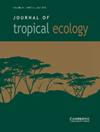Differences in the structure of bat assemblages among habitats in the Caatinga dry forest
IF 1
4区 环境科学与生态学
Q4 ECOLOGY
引用次数: 0
Abstract
The Caatinga is the largest seasonal tropical dry forest with extreme environmental and meteorological conditions. It harbours many phytophysiognomies and vegetational units, but bat fauna is poorly known in many regions. We analysed the structure of bat assemblages by mist-netting during 99 nights in seven habitats throughout six sites in the northeasternmost region of the Caatinga in Rio Grande do Norte State, in the Brazilian northeast. With a sampling effort of 239 665 m2h, we captured 1575 individuals of 31 species of bats. Bat assemblages’ structure and species distribution changed according to the habitat type, and differences in richness, abundance, species composition, and trophic guild representation were found. The frugivore卡廷加干旱林生境中蝙蝠群落结构的差异
卡廷加森林是世界上最大的季节性热带干燥森林,具有极端的环境和气象条件。它拥有许多植物地貌和植被单位,但蝙蝠动物群在许多地区鲜为人知。我们在巴西东北部北里奥格兰德州Caatinga最东北地区的6个地点的7个栖息地,通过雾网分析了99个夜晚的蝙蝠组合结构。在239 665 m2h的采样努力下,我们捕获了31种蝙蝠1575只。生境类型不同,蝙蝠群落结构和种类分布也不同,在丰富度、丰度、物种组成和营养行会代表性等方面存在差异。果食性植物A. planirostris分布广泛,并且在所有生境中都保持着过剩。最丰富的物种在每个栖息地都有几个独特的物种,这表明物种和营养行会对特定栖息地有特定的偏好。蝙蝠组合结构的差异可能是由每个栖息地的植被结构和植物组成(例如,半开放栖息地与高大的林分)驱动的,这些栖息地提供不同的可利用资源(例如,食物和栖息地)。最后,我们讨论了觅食栖息地对保护Caatinga干旱林最东北部地区这些独特蝙蝠群落的重要性。
本文章由计算机程序翻译,如有差异,请以英文原文为准。
求助全文
约1分钟内获得全文
求助全文
来源期刊

Journal of Tropical Ecology
环境科学-生态学
CiteScore
2.10
自引率
0.00%
发文量
44
审稿时长
18-36 weeks
期刊介绍:
Journal of Tropical Ecology aims to address topics of general relevance and significance to tropical ecology. This includes sub-disciplines of ecology, such as conservation biology, evolutionary ecology, marine ecology, microbial ecology, molecular ecology, quantitative ecology, etc. Studies in the field of tropical medicine, specifically where it involves ecological surroundings (e.g., zoonotic or vector-borne disease ecology), are also suitable. We also welcome methods papers, provided that the techniques are well-described and are of broad general utility.
Please keep in mind that studies focused on specific geographic regions or on particular taxa will be better suited to more specialist journals. In order to help the editors make their decision, in your cover letter please address the specific hypothesis your study addresses, and how the results will interest the broad field of tropical ecology. While we will consider purely descriptive studies of outstanding general interest, the case for them should be made in the cover letter.
 求助内容:
求助内容: 应助结果提醒方式:
应助结果提醒方式:


